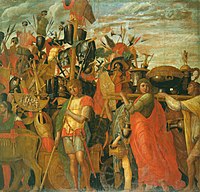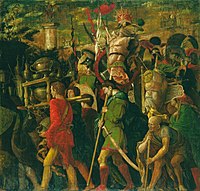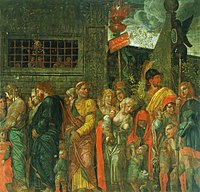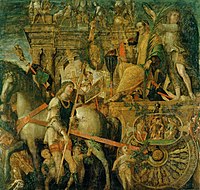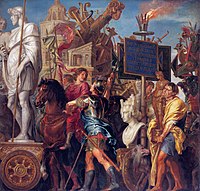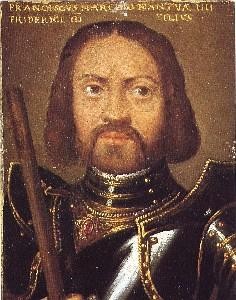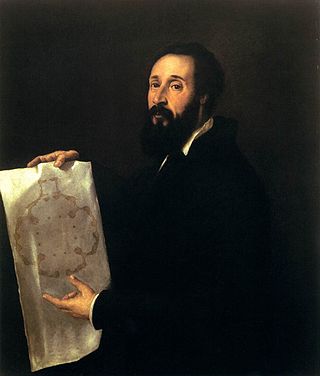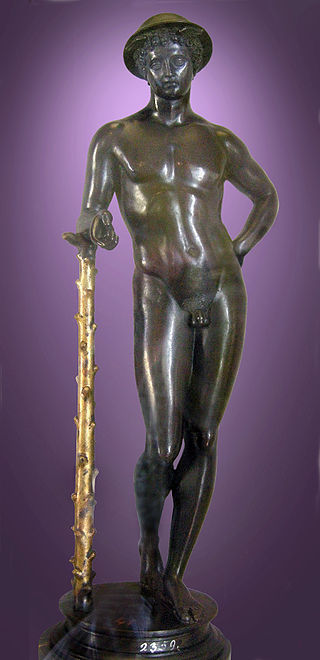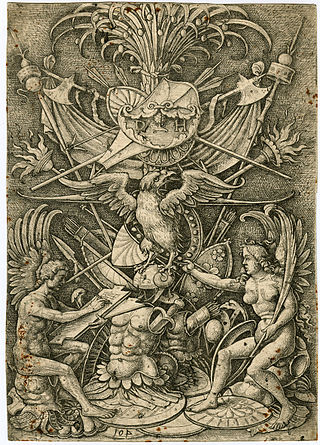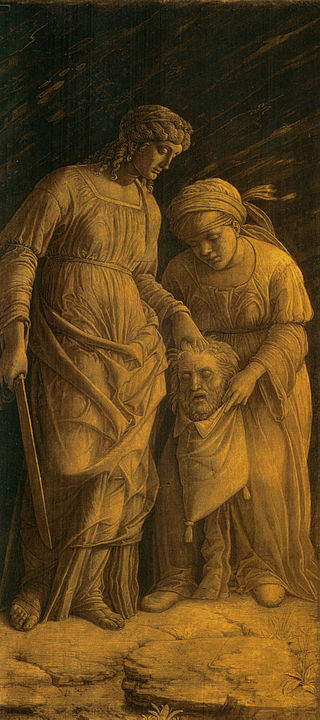| Painting and features | Plutarch – Lives | Appian – Roman History, Book VIII | Suetonius – The Twelve Caesars |
|---|
| Life of Aemilius Paulus (trans. Leonardi Bruni, Rome c 1470) | Trans. Pietro Candido Decembrio, Venice c 1477 | Life of Caesar |
| English translation | John Dryden (1683) [14] | Horace White (writer) (Loeb,1912) [15] | John Carew Rolfe (Loeb, 1920) [16] |
| Canvas I: Picture bearers | | | |
| Trumpeters | | Trumpeters led the advance and wagons laden with spoils. | |
| Emblems and banners | This triumph lasted three days. On the first, which was scarcely long enough for the sight, were to be seen the statues, pictures, ... | | |
| Canvas II: Standard bearers | | | |
| Colossal statues on carts | ... and colossal images which were taken from the enemy, drawn upon two hundred and fifty chariots. | | |
| Model of a city, plaques with inscriptions, statues | | Towers were borne along representing the captured cities, and pictures showing the exploits of the war | |
| Canvas III: Bearers of trophies and bullion | | | |
| Trophies of captured weapons | On the second [day] was carried in a great many wagons the finest and richest armour of the Macedonians, both of brass and steel, all newly polished and glittering the pieces of which were piled up and arranged purposely with the greatest art, so as to seem to be tumbled in heaps carelessly and by chance: helmets were thrown upon shields, coats of mail upon greaves; Cretan targets, and Thracian bucklers and quivers of arrows, lay huddled amongst horses' bits, and through these there appeared the points of naked swords, intermixed with long Macedonian sarissas. | | |
| Bearers of booty and coins | After these wagons loaded with armour there followed three thousand men who carried the silver that was coined, in seven hundred and fifty vessels, each of which weighed three talents, and was carried by four men. | then gold and silver coin and bullion, and whatever else they had captured of that kind | |
| Canvas IV: Vase bearers | | | |
| Bearers of booty and crowns | Others brought silver bowls and goblets and cups, all disposed in such order as to make the best show, and all curious as well for their size as the solidity of their embossed work. | then came the crowns that had been given to the general as a reward for his bravery by cities, by allies, or by the army itself. | |
| White oxen | | White oxen came next, ... | |
| Canvas V: Elephants | | | |
| Trumpeters, white oxen | On the third day, early in the morning, first came the trumpeters, who did not sound as they were wont in a procession or solemn entry, but such a charge as the Romans use when they encourage the soldiers to fight. Next followed young men wearing frocks with ornamented borders, who led to the sacrifice a hundred and twenty stalled oxen, with their horns gilded, and their heads adorned with ribbons and garlands; and with these were boys that carried basins for libation, of silver and gold. | | |
| Elephants with candelabras | | and after them elephants | and he mounted the Capitol by torchlight, with forty elephants bearing lamps on his right and his left. |
| Canvas VI: Corselet bearers | | | |
| Bearers of booty and coins, trophies of arms | After this was brought the gold coin, which was divided into vessels that weighed three talents, like those that contained the silver; they were in number seventy-seven. These were followed by those that brought the consecrated bowl which Aemilius had caused to be made, that weighed ten talents, and was set with precious stones. Then were exposed to view the cups of Antigonus and Seleucus, and those of the Thericlean make, and all the gold plate that was used at Perseus's table. Next to these came Perseus's chariot, in which his armour was placed, and on that his diadem. | | |
| Canvas VII: Captives | | | |
| Captives, buffoons | And, after a little intermission, the king's children were led captives, and with them a train of their attendants, masters, and teachers, all shedding tears, and stretching out hands to the spectators, and making the children themselves also beg and entreat their compassion. There were two sons and a daughter, whose tender age made them but little sensible of the greatness of their misery, which very insensibility of their condition rendered it the more deplorable; insomuch that Perseus himself was scarcely regarded as he went along, whilst pity fixed the eyes of the Romans upon the infants; and many of them could not forbear tears, and all beheld the sight with a mixture of sorrow and pleasure, until the children were passed. | | |
| Canvas VIII: Musicians | | | |
| Musicians | | Lietors clad in purple tunics preceded the general; also a chorus of musicians and pipers, in imitation of an Etruscan procession, wearing belts and golden crowns, and they march evenly with song and dance. They call themselves Lydi because, as I think, the Etruscans were a Lydian colony. One of these, in the middle of the procession, wearing a purple cloak and golden bracelets and necklace, caused laughter by making various gesticulations, as though he were insulting the enemy. | |
| Signifers | After these were carried four hundred crowns, all made of gold, sent from the cities by their respective deputations to Aemilius, in honour of his victory. | Next came incense bearers. | |
| Canvas IX: Julius Caesar | | | |
| Caesar in his chariot | Then he himself came, seated on a chariot magnificently adorned (a man well worthy to be looked at, even without these ensigns of power), dressed in a robe of purple, interwoven with gold, and holding a laurel branch in his right hand. | ... and after them the general himself on a chariot embellished with various designs, wearing a crown of gold and precious stones, and dressed, according to the fashion of the country, in a purple toga embroidered with golden stars. He bore a sceptre of ivory, and a laurel branch, which is always the Roman symbol of victory. Riding in the same chariot with him were boys and girls, and on horses on either side of him young men, his own relatives. Then followed those who had served him in the war as secretaries, aids, and armor-bearers. | In his Pontic triumph he displayed among the show-pieces of the procession an inscription of but three words, "I came, I saw, I conquered" – Veni, vidi, vici |
| Engraving: Senators | | | |
| Senators | All the army, in like manner, with boughs of laurel in their hands, divided into their hands and companies, followed the chariot of their commander; some singing verses, according to the usual custom, mingled with raillery; others, songs of triumph and the praise of Aemilius's deeds. | After these came the army arranged in companies and cohorts, all of them crowned and carrying laurel branches, the bravest of them bearing their military prizes. They praised some of their captains, derided others, and reproached others; for in a triumph everybody is free, and is allowed to say what he pleases. | |






